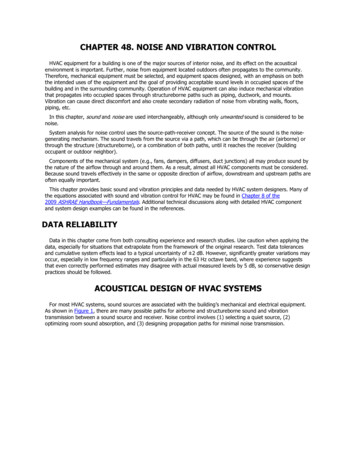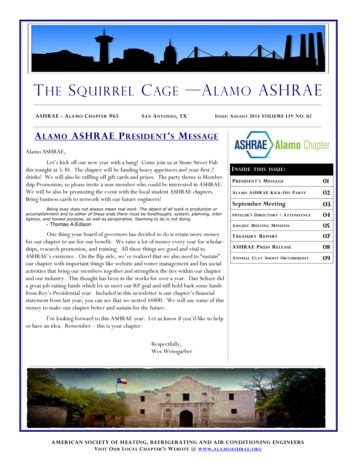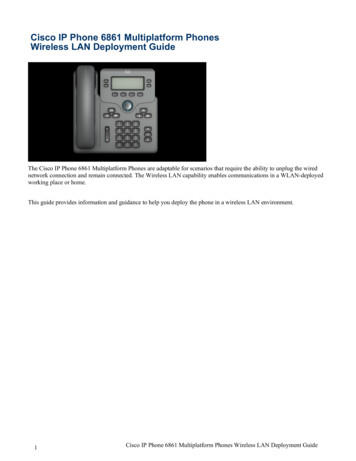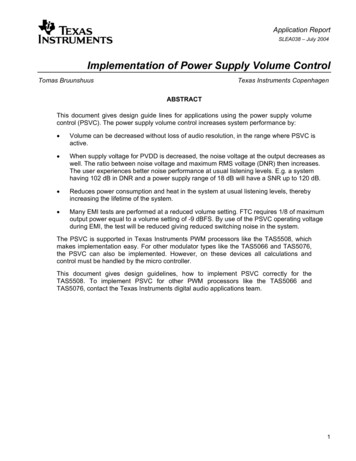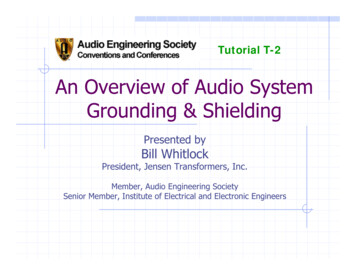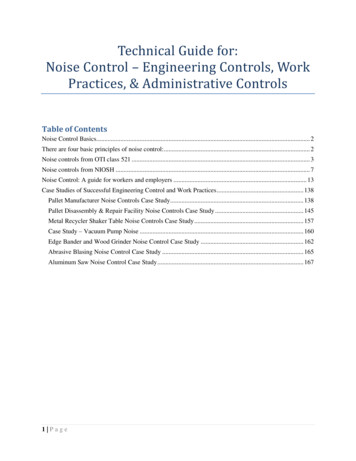
Transcription
Technical Guide for:Noise Control – Engineering Controls, WorkPractices, & Administrative ControlsTable of ContentsNoise Control Basics. 2There are four basic principles of noise control:. 2Noise controls from OTI class 521 . 3Noise controls from NIOSH . 7Noise Control: A guide for workers and employers . 13Case Studies of Successful Engineering Control and Work Practices . 138Pallet Manufacturer Noise Controls Case Study. 138Pallet Disassembly & Repair Facility Noise Controls Case Study . 145Metal Recycler Shaker Table Noise Controls Case Study . 157Case Study – Vacuum Pump Noise . 160Edge Bander and Wood Grinder Noise Control Case Study . 162Abrasive Blasing Noise Control Case Study . 165Aluminum Saw Noise Control Case Study . 1671 Page
Noise Control BasicsThree primary means of controlling noise in the workplace Engineering controls – a physical modification made to the source of noise or the permanentphysical environment around the source of the noise. Examples: addition of walls, installation ofnoise adsorbing material to walls, layering of rubber between metal plates, or using rubber padsunder motor mounts. Work practices – changes made to how a job or task is performed, or materials used in the job ortask. Examples: moving employee work station away from noise source, changing to anotherform of raw material. Administrative controls – adjustments to the allocation of employees or employees time inregards to the source of the noise. Examples: employee rotation or time limits for employeesworking in certain areas.There are four basic principles of noise control: Sound insulation: prevent the transmission of noise by the introduction of a mass barrier.Common materials have high-density properties such as brick, concrete, metal etc. Sound absorption: a porous material which acts as a ‘noise sponge’ by converting the soundenergy into heat within the material. Common sound absorption materials include open cell foamsand fiberglass Vibration damping: applicable for large vibrating surfaces. The damping mechanism works byextracting the vibration energy from the thin sheet and dissipating it as heat. A common materialis sound deadened steel. Vibration isolation: prevents transmission of vibration energy from a source to a receiver byintroducing a flexible element or a physical break. Common vibration isolators are springs,rubber mounts, cork etc.2 Page
Noise controls from OTI class 5213 Page
4 Page
5 Page
6 Page
Noise controls from ERING AND ADMINISTRATIVE CONTROLSEngineering and administrative controls are essential to achieve an effective hearing lossprevention program. Engineering and administrative controls represent the first two echelons inthe NIOSH Hierarchy of Controls: 1) remove the hazard, 2) remove the worker. The use of thesecontrols should reduce hazardous exposure to the point where the risk to hearing is eliminated orat least more manageable. Engineering controls are technologically feasible for most noisesources but their economic feasibility must be determined on a case-by-case basis. In someinstances the application of a relatively simple noise control solution reduces the hazard to theextent that the other elements of the program, such as audiometric testing and the use of hearingprotection devices, are no longer necessary. In other cases, the noise reduction process may bemore complex, and must be accomplished in stages over a period of time. Even so, with eachreduction of a few decibels, the hazard to hearing is reduced, communication is improved, andnoise-related annoyance is reduced as well.It is especially important that companies specify low noise levels when purchasing newequipment. Many types of previously noisy equipment are now available in noise-controlledversions, so a "buy quiet" purchase policy should not require new engineering solutions in manycases.A summary of OSHA's requirements for engineering and administrative controls can be found initems no. 1-3 of Appendix A in this guidebook. Readers may obtain some practical guidance inthe section entitled "Engineering and Administrative Controls" of Appendix B.For hearing loss prevention purposes, engineering controls are defined as any modification orreplacement of equipment, or related physical change at the noise source or along thetransmission path (with the exception of hearing protectors) that reduces the noise level at theemployee's ear.Typical engineering controls involve:1. Reducing noise at the source.2. Interrupting the noise path.3. Reducing reverberation.4. Reducing structure-borne vibration.Common examples of the implementation of such controls are:7 Page
1. Installing a muffler.2. Erecting acoustical enclosures and barriers.3. Installing sound absorbing material.4. Installing vibration mounts and providing proper lubrication.Assessing the applicability of engineering controls is a sophisticated process. First, the noiseproblem must be thoroughly defined. This necessitates measuring the noise levels anddeveloping complete information on employee noise exposure and the need for noise reduction.Next, an approach to engineering control must be developed, requiring the identification ofindividual noise sources and an assessment of their contributions to the overall noise levels.Once identified and analyzed, the above controls can be considered. Those chosen will beinfluenced, to some extent, by the cost of purchasing, operating, servicing, and maintaining thecontrol. For this reason, engineering, safety, and industrial hygiene personnel, as well asemployees who operate, service, and maintain equipment, must be involved in the noise-controlplan. Employees who work with the equipment on a daily basis will be able to provide valuableguidance on such important matters as the positioning of monitoring indicators and panels,lubrication and servicing points, control switches, and the proper location of access doors foroperation and maintenance. It also may be desirable to obtain the services of an acousticalconsultant to assist in the design, implementation, installation, and evaluation of these controls.In the design and installation of engineering noise controls, ergonomics must be consideredalong with optimal work efficiency. For example, work posture (sitting, standing, bending) aswell as existing environmental factors (lighting, heating, and cooling) must be considered. Thisis especially true with employee enclosures or booths. Lighting, heating, and cooling must ensurecomfort and be sufficient to prevent reduction in efficiency and work quality. Enclosures shouldbe of adequate size and have enough window area to prevent claustrophobia. Windows should bepositioned carefully to enhance proper usage by employees, and the glass may need to be tiltedto prevent glare. In situations where employees will be working on or around equipment fittedwith engineering controls, it is important to explain to everyone involved why the controlsshould not be modified, removed, or otherwise defeated.Administrative controls, defined as changes in the work schedule or operations which reducenoise exposure, may also be used effectively. Examples include operating a noisy machine on thesecond or third shift when fewer people are exposed, or shifting an employee to a less noisy jobonce a hazardous daily noise dose has been reached. Generally, administrative controls havelimited use in industry because employee contracts seldom permit shifting from one job toanother. Moreover, the practice of rotating employees between quiet and noisy jobs, although itmay reduce the risk of substantial hearing loss in a few workers, may actually increase the risk ofsmall hearing losses in many workers.A more practical administrative control is to provide for quiet areas where employees can gainrelief from workplace noise. Areas used for work-breaks and lunch rooms should be locatedaway from noise. If these areas must be near the production line, they should be acoustically8 Page
treated to minimize background noise levels. Much literature is available describing methods andprocedures for noise measurement and analysis, instrumentation, engineering noise controls,performance characteristics of noise control materials, and case histories of the implementationof noise control solutions. Suggested readings are listed in Appendix D.9 Page
10 P a g e
Management ResponsibilitiesManagement's primary responsibilities are to make sure that potentially controllable noisesources are identified, and that priorities for controls are set and accomplished. For this purpose,management needs to allocate the appropriate resources and engage outside services or identifycapable personnel in-house. It is also management's responsibility to see that any changes ofequipment or process are done only after evaluation of their impact on employee noise exposure.The purchase of quieter new equipment can be very helpful, but is usually accomplished onlywith explicit specification, and occasionally some pressure on the equipment manufacturers.Sometimes the company must be willing to pay more for quieter equipment, but theseexpenditures should be cost-effective in the long run.Often a noise-control effort may seem to be overwhelming. As a result, the company may decidethat noise control is not feasible and rely on hearing loss prevention measures to prevent hearingloss. However, if noise sources are taken on one at a time, dealing with the noisiest or easiest toquiet sources first, the problem can become manageable over time so that hearing loss preventionmeasures will be needed only until the noise is reduced to a safe level. Many times two hazardscan be ameliorated at once such as in the case of enclosing a noisy machine that generates highheat levels as well. The enclosure can trap the noise and the heat can be vented off to the outside.The time when workplace noise is no longer hazardous will be hastened if the control of noisefrom current sources is augmented by a "buy quiet" program.Managers may need to commit resources for in-house development of technology to controlexposure problems specific to their companies and processes. In some cases they may need tobudget for maintenance of exposure control devices to prevent their deterioration over time.Finally, they should make sure that lunch and break areas are as free from hazards as reasonablypossible, and that other avenues of administrative controls have been explored.11 P a g e
Program Implementor ResponsibilitiesOne of the most important responsibilities of the hearing loss prevention program implementor isto make sure that management is aware of the need for engineering controls and their benefits.He or she should see that the company has thoroughly assessed the full potential for using bothengineering and administrative controls.Those who implement the hearing loss prevention program will probably not actually execute theexposure control solutions, but will provide a channel between the employees who operate theequipment, management, and the noise control specialists. It is the job of the implementor tomake sure that communication lines are open, and that the equipment operators are consulted incontrol design. Program implementors will be responsible for making sure that employeesunderstand the proper use of noise control devices, and for maintaining them in good condition.Employee ResponsibilitiesBecause the employees who operate or maintain and repair the equipment are often the ones whoknow most about the processes involved, they need to express their concerns and ideas tomanagement, the program implementor, or the noise-control engineer, so that the noise-controldevices will be as practical and effective as possible. Employees also have the responsibility oflearning to operate their machines with the noise controls in place, of maintaining the controlsproperly, and of notifying the appropriate personnel when additional maintenance is needed.Further ReadingBeranek LL, ed.[1988] Noise and Vibration Control. revised. New York: McGraw Hill.Bruce RD, Toothman EH [1986]. Engineering controls. In: Berger EH, Ward W.D, Morrill, JC,Royster LH, eds. Noise and Hearing Conservation Manual. 4th ed. Akron, OH: AmericanIndustrial Hygiene Assoc. Chapter 12.Harris CM ed. [1991] Handbook of Noise Control. 3rd ed. New York: McGraw Hill, Chapters 26and 30-41.OSHA. [1980]. Noise Control: A Guide for Workers and Employers. Pub. No. 3048.Washington, D.C. U.S. Dept. of Labor/OSHA, Office of Information.12 P a g e
Noise Control: A guide for workers and employersU.S. Department of LaborOccupational Safety and Health AdministrationContentsINTRODUCTIONNOISE: ITS EFFECT ON HEALTHNOISE CONTROL: BASIC CONCEPTS AND TERMSAPPLICATION OF NOISE CONTROL PRINCIPLESA. Sound BehaviorB. Sound from Vibrating PlatesC. Sound Production in Air of GasesD. Sound Production in Flowing LiquidsE. Sound Movement IndoorsF. Sound Movement in DuctsG. Sound from Vibrating MachinesH. Sound Reduction in Enclosure WallsNOISE CONTROL MEASURESChanges in Machinery and EquipmentMaterials HandlingEnclosure of MachinesControl of Noise from Vibrating SurfacesDamping with AbsorbantsSound Insulating Separate RoomsMaintenancePlanning for Noise ControlHOW OSHA CAN HELP EMPLOYERS AND EMPLOYEESIntroductionNoise.It can destroy hearing.It can create physical and psychological stress.13 P a g 110112
And it can contribute to accidents by making it impossible to hear warning signals.An estimated 14 million workers in the U.S. are exposed to hazardous noise.Luckily, noise exposure can be controlled. No matter what the noise problems may be in aparticular workplace, technology exists to reduce the hazard.It may be possible to: Use quieter work processes.Alter or enclose equipment to reduce noise at the source.Use sound-absorbing materials to prevent the spread of noise by isolating the source.In the field of noise control, where there's a will, there's a way.The Occupational Safety and Health Administration (OSHA) was established by the U.S.Congress to help eliminate job safety and health hazards such as noise.This book is presented by OSHA for workers and employers interested in reducing workplacenoise. OSHA believes that highly technical training is not generally necessary in order tounderstand the basic principles of noise control. Noise problems can often be solved by theworkers and employers who are directly affected.The book contains five major sections.First, a brief overview of the effects of noise on human healthSecond, a discussion of some of the key words and concepts involved in noise control.Third, an explanation of specific principles of noise control which the reader can apply in his orher workplace.Fourth, a discussion of particular techniques for controlling noise.Fifth, a description of the ways OSHA can help employers and employees, including anexplanation of the legal requirements for noise control which employers must follow.OSHA hopes that the information in this book will be discussed by employers, workers, andunion representatives. If more help is needed, contact the nearest OSHA area office listed in theback of the book.1Noise: Its effect on health14 P a g e
The ability to hear is one of our most precious gifts. Without it, it is very difficult to lead a fulllife either on or off the job.Excessive noise can destroy the ability to hear, and may also put stress on other parts of thebody, including the heart.For most effects of noise, there is no cure, so that prevention of excessive noise exposure is theonly way to avoid health damage.HearingThe damage done by noise depends mainly on how loud it is and on the length of exposure. Thefrequency or pitch can also have some effect, since high-pitched sounds are more damaging thanlow-pitched ones.Noise may tire out the inner ear, causing temporary hearing loss. After a period of time off,hearing may be restored. Some workers who suffer temporary hearing loss may find that by thetime their hearing returns to normal, it is time for another work shift, so, in that sense, theproblem is "permanent."With continual noise exposure, the ear will lose its ability to recover from temporary hearingloss, and the damage will become permanent. Permanent hearing loss results from thedestruction of cells in the inner ear-cells which can never be replaced or repaired. Such damagecan be cause by long-term exposure to loud noise or, in some cases, by brief exposures to veryloud noises.Normally, workplace noise first affects the ability to hear high frequency (high-pitched) sounds.This means that even though a person can still hear some noise, speech or other sounds may beunclear or distorted.Workers with hearing impairment typically say "I can hear you, but I can't understand you."Distortion occurs especially when there are background noises or many people talking. Asconversation becomes more difficult to understand, the person becomes isolated from family andfriends. music and the sounds of nature become impossible to enjoy.A hearing aid can make speech louder, but cannot make it clearer, and is rarely a satisfactoryremedy for hearing loss.Workers suffering from noise-induced hearing loss may also experience continual ringing intheir ears, called "tinnitus." At this time there is no cure for tinnitus, although some doctors areexperimenting with treatment.Other effects15 P a g e
Although research on the effects of noise is not complete, it appears that noise can causequickened pulse rate, increased blood pressure and a narrowing of the blood vessels. Over a longperiod of time, these may place an added burden on the heart.Noise may also put stress on other parts of the body by causing the abnormal secretion ofhormones and tensing of muscles (see Figure 1).Workers exposed to noise sometimes complain of nervousness, sleeplessness and fatigue.Excessive noise exposure also can reduce job performance and may cause high rates ofabsenteeism.216 P a g e
Figure 1. In addition to causing hearing loss by destroying the inner ear, noise apparently canput stress on other parts of the body by causing reactions such as those shown at left.Figure 2. Severe destruction of the hair cells in the hearing organ. Top picture: normal haircells, lower picture: hair cells destroyed by noise.17 P a g e
3Noise control: Basic concepts and termsThere are a number of words and concepts which must be understood before beginning adiscussion of noise control methods.SoundSound is produced when a sound source sets the air nearest to it in wave motion. The motionspreads to air particles far from the sound source. Sound travels in air at a speed of about 340meters per second. The rate of travel is greater in liquids and solids; for example, 1,500 m/s inwater and 5,000 m/s in steel.(Note: Measurements in this book are generally given in the metric system. To convert, onemeter equals about 39.4 inches, and one millimeter equals 0.04 inches, and one kilogramequals about 2.2 pounds.)Frequency (Hz)The frequency of a sound wave refers to the number of vibrations per second, measured in unitsof hertz (Hz). Sound is found within a large frequency range; audible sound for young [continuedon next page]Figure 3. The sound source vibrates and affects air particles, which strike the ear drum.18 P a g e
Figure 4. A pure tone is marked by a single column indicating the frequency and the sound levelor intensity. Musical notes contain several tones of different frequencies and intensities.4persons is between about 20 Hz and 20,000 Hz.The boundary between high and low frequencies is generally established at 1,000 Hz.Sound may consist of a single pure tone, but in general it is made up of several tones of varyingintensities.NoiseIt is customary to call any undesirable sound "noise." [sic] The disturbing effects of noise dependboth on the intensity and the frequency of the tones. For example, higher frequencies are moredisturbing than low ones. Pure tones are more disturbing than a sound made up of many tones.Infrasound and ultrasoundSound with frequencies below 20 Hz is called infrasound, and sound with more than 20,000 Hzis called ultrasound. There is some evidence that these sounds which cannot be heard can undercertain conditions be hazardous to workers' health. This book deals only with noise which can beheard.Figure 5. Noise is a disorderly mixture of tones at many frequencies.519 P a g e
Figure 6. At the same intensity, the noise from a truck is less disturbing than the sound of airblowing or suction because it is at a lower frequency.6Decibel (dB)Sound levels are measured in units of decibels (dB). If sound is intensified by 10 dB, it seems tothe ears approximately as if the sound intensity has doubled. A reduction by 10 dB makes it seemas if the intensity has been reduced by half.Noise level measurementIn measuring sound levels, instruments are used which resemble the human ear in sensitivity tonoise composed of varying frequencies. The instruments measure the "A-weighted sound level"in units called dB(A).20 P a g e
Workplace noise measurements indicated the combined sound levels of tool noise from a numberof sources (machinery and materials handling) and background noise (from ventilation systems,cooling compressors, circulation pumps, etc.).Figure 7.7In order to accurately identify all workplace noise problems, the noise from each source shouldalso be measured separately. Measurements at various production rates may be useful inconsidering possible control measures. A number of manuals for noise measurements arecommercially available.Adding noise levels21 P a g e
Decibel levels for two or more sounds cannot simply be added. Figure 8 shows how thecombined effect of two sounds depends on the difference in their levels. Two or more sounds ofthe same level combine to make a higher noise level.Octave bandIt is common practice to divide the range of frequencies we can hear into eight octave bands. Thesound level is then listed for each octave band. The top frequency in an octave band is alwaystwice the bottom one. The octave band may be referred to by a center frequency. For example,500 Hz is the center frequency for the octave band 354-708 Hz.numberofdecibelsto addtohigherof twolevelsFigure 8. A fan produces a sound level of 50 dB(A). Another fan produces 56 dB(A). Thedifference is 6 dB(A), and according to the diagram, 1 dB(A) will be added to the highest level.Operating together, the fans will result in a level of 57 dB(A).Sound transmissionThe word "sound" usually means sound waves traveling in air. However, sound waves also travelin solids and liquids. These sound waves may be transmitted to air to make sound we can hear.ResonanceEach object or volume of air will "resonate," or strengthen a sound, at one or more particularfrequencies. The frequency depends on the size and construction of the object or air volume.Sound reduction by distanceSound spreading in open air and measured at a certain distance from the source is reduced byabout 6 dB for each doubling of that distance. Sound is reduced less when spreading inside aroom. (See Figure 9.)22 P a g e
8Sound transmission loss (TL)When a wall is struck by sound, only a small portion of the sound is transmitted through the wall,while most of it is reflected. The wall's ability to block transmission is indicated by itstransmission loss (TL) rating, measured in decibels. The TL of a wall does not vary regardless ofhow it is used.Noise reduction (NR)Noise reduction is the number of decibels of sound reduction actually achieved by a particularenclosure or barrier. This can be measured by comparing the noise level before and afterinstalling an enclosure over a noise source. NR and TL are not necessarily the same.Sound absorptionSound is absorbed when it strikes a porous material. Commercial sound-absorbing materialsusually absorb 70 percent or more of the sound that strikes them.Figure 9. If a small sound source produces a sound level of 90 dB at a distance of 1 meter, thesound level at a 2 meter distance is 84 dB, at 4 meters 78 dB, etc.23 P a g e
Figure 10. Part of the sound that strikes a wall is reflected, part is absorbed, and part istransmitted. The transmission loss (TL) of the wall is determined by the portion of the noisewhich is not transmitted through the wall.9Application of noise control principlesThe following section explains how to apply basic noise control principles. In many cases,several principles must be applied and several control measures must be taken. Of course, theseprinciples do not cover every possible noise problem.The principles are discussed in eight sections:A. Sound behaviorB. Sound from vibrating platesC. Sound production in air or gasesD. Sound production in flowing liquidsE. Sound movement indoorsF. Sound movement in ductsG. Sound from vibrating machinesH. Sound reduction in enclosure walls24 P a g e
A number of symbols are used throughout the drawings. For example, large black arrowsindicate strong sound radiation and smaller ones show reduced radiation.11SOUND BEHAVIOR - CAUSES OF SOUND PRODUCTION - A1Changes in force, pressure, or speed produce noiseSound is always produced by changes in force, pressure, or speed. Great changes produce loudernoises and small changes quieter ones. More noise is produced if a task is carried out with greatforce for a short time than with less force for a longer time.Principle12Example25 P a g e
In a box machine, cardboard is cut with a knife blade. The knife must cut very rapidly and withgreat force in order for the cut to be perpendicular to the strip Much noise results.Control MeasureUsing a blade which travels across the strip, the cardboard can be scored with minimal force fora longer time. Since the cardboard strip continues to move, the knife must travel at an angle inorder for the cut to be perpendicular. The cutting is practically noise free.1326 P a g e
SOUND BEHAVIOR - CAUSES OF SOUND PRODUCTION - A2Airborne sound is usually caused by vibration in solids orturbulence in fluidsFor example, vibrations of the strings in a musical instrument are transmitted through the bridgeto the sound box. When the sound box vibrates, sound is transmitted to the air. A circulationpump produces pressure variations in the water in a heating system. The sound waves aretransmitted through the pipes to the radiators, whose large metal surfaces transmit airbornesound.14ExampleTurbulent fluid flow within pipes produces sound which can be radiated from the pipes and eventransmitted to the building structure.27 P a g e
Control measureIn addition to reducing the turbulence in the pipe, the pipe can be covered with sound absorbingmaterial. The vibrations can be isolated from the wall or ceiling with flexible connectingmechanisms.15SOUND BEHAVIOR - CAUSES OF SOUND PRODUCTION - A328 P a g e
Vibrations can produce sound after traveling great distancesVibrations in solids and liquids can travel a great distance before producing airborne sound. Suchvibrations can cause distant structures to resonate. The best solution is to stop the vibration asclose to the source as possible.Principle16ExampleVibrations from an elevator are transmitted throughout a building.29 P a g e
Control measureThe elevator drive can be isolated from the building structure.30 P a g e
17SOUND BEHAVIOR - LOW AND HIGH FREQUENCIES - A4The slower the repetition, the lower the frequency of thenoiseThe level of low frequency noise from a sound source is determined primarily by the rate atwhich the changes in force, pressure, and speed are repeated. The longer the time betweenchanges, the lower the frequency of the noise generated. The level of noise depends on theamount of the change.Principle31 P a g e
18ExampleTwo gears have the same pitch diameter but different numbers of teeth. If they rotate at the samespeed, the gear with fewer teeth will produce a lower frequency noise.32 P a g e
19SOUND BEHAVIOR - LOW AND HIGH FREQUENCIES - A5High frequency sound is strongly directional and more easilyreflectedWhen high frequency sound strikes a hard surface, it is reflected much like light from a mirror.High frequency sound does not travel around corners easily.Principle33 P a g e
20ExampleHigh frequency noise travels directly from the high-speed riveting machine to the worker's ears.Control measure34 P a g e
A sound-insulating hood, open toward the bottom of the machine, is constructed above thehammer. The hood is coated on the inside with sound-absorbing material. The upper portion ofthe opening is covered with safety glass. As sound starts tow
management, the program implementor, or the noise-control engineer, so that the noise-control devices will be as practical and effective as possible. Employees also have the responsibility of learning to operate their machines with the
